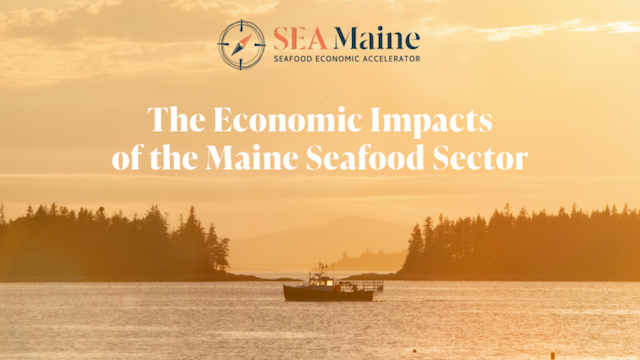|
This is the first economic report that examines the entire seafood sector, including downstream contributors.
PORTLAND, MAINE (May 31, 2023)— Maine seafood is central to the state’s economic identity both in Maine and beyond. The seafood sector value chain collectively supports thousands of jobs and billions of dollars of revenue and output as well as contributing to the prosperity of Maine’s coastal communities.
The report was commissioned by the Seafood Economic Accelerator for Maine (SEA Maine), an industry-led initiative that brings together leaders in Maine’s commercial fishing, aquaculture, and the marine economy. The goal of the project was to quantify, for the first time, the economic contribution of the entire seafood sector to the Maine economy and provide the necessary tools to make data driven policy decisions regarding the sector as a whole and the marketing of the sector. The report focuses on the domestic commercial seafood sector in Maine and will serve as a baseline to measure growth and evaluate the impact of specific investments or initiatives in the sector.
Charlotte Mace from the Maine Department Economic & Community Development and member of the SEAMaine Steering Committee, said, “The seafood industry is one of the state’s biggest resources and a significant contributor to our economy. Having this type of data helps inform the best ways to diversify and grow our Marine economy.”
Highlights from the report include:
- The seafood sector contributed over $3.2 billion dollars in total economic output to the Maine economy in 2019. Retail seafood ($692 million), lobster harvesting ($511 million), and seafood processing ($343 million) were the largest industries contributing to total economic output.
- The sector supported over 33,300 jobs statewide in 2019, including 23,846 in sector industries and 7,300 additional jobs supported from other indirect and induced multiplier effects. Harvestingincluding lobster, non-lobster species and aquaculture is the largest employing segment of the seafood sector, supporting over 12,700 jobs, followed by retail seafood outlets, including restaurants (8,550).
- Employment supported $1.3 billion in total labor income, $967 million of which was from direct employment in value chain industries and another $336 million resulting from indirect and induced multiplier effects. Contributions to labor income were led by lobster harvesting ($393 million), retail ($285 million), and all other non-lobster species harvesting ($155 million).
- The seafood sector supported an estimated $449 million in tax revenues in 2019, including local, state, and federal. The sector supported nearly $91 million in local and $110 million in state tax revenues. A total of $248 million in federal tax revenues were also supported.
- Regionally, the seafood sector in the Downeast region accounted for 45 percent of all direct jobs (and 47.4% of total impact jobs) and supported $390 million in labor income (16 percent) in 2019. The seafood sector Downeast supports slightly more jobs than Southern Maine despite having lessthan one-fifth of the population. Downeast seafood jobs were concentrated in the harvesting subsector — the region accounted for 65 percent of all harvesting jobs in the seafood sector statewide in 2019. These estimates are likely conservative as a result of a significant amount of harvesting activity that did not have geographic identifying information attached — accounting for nearly 3,700 jobs.
- The seafood sector supported over 10,000 jobs and over $260 million in labor income in 2019 in the Midcoast region. The sources of economic impacts from the seafood sector are concentrated in lobster harvesting and retail for the region, with aquaculture comprising a smaller but growing source of jobs and income in the region.
- In Southern Maine, the seafood sector supported over 7,600 jobs and $370 million in labor income— slightly less than Downeast. The bulk of direct jobs were supported by the retail industry sector (over 4,000), while harvesting (all species wild caught) supported roughly 1,240 jobs.
- The seafood sector’s total economic impact is a much larger share of the Downeast region’s economy, accounting for almost 20% of employment, than the sector comprises in the Midcoast or Southern economies.
This study focused on 2019, prior to the Covid pandemic. The continual updating and improvement of economic data for the seafood sector and individual industries should be a high priority for the industry and policy makers.
“Creating an economic baseline for the entire seafood sector is a fundamental building block for Maine. This baseline study will allow us to accurately measure growth going forward, and help attract investment”, said Sebastian Belle, Executive Director of the Maine Aquaculture Association and SEA Maine Committee Member.
“We need to embrace these opportunities and educate people on the resiliency of this resource we have here in Maine and show how we are poised for economic growth,” said Ben Martens, Executive Director of the Maine Coast Fishermen’s Association and SEA Maine Advisory Panel Member. “The work of SEA Maine with the research and report findings is spearheading a roadmap and a bridge to the future that will sustain our industry.”
The report was undertaken by the Middlebury Institute for International Studies Center for the Blue Economy (CBE) and the University of Southern Maine Center for Business and Economic Research (CBER).
To download the full “Economic Impact” report please visit SEA Maine. About SEA Maine
Media Contact:
Angie Helton, Northeast Media Associates 207-653-0365
angie@nemediaassociates.com
SEA Maine, or the Seafood Economic Accelerator for Maine, is an industry-led initiative bringing together leaders in Maine’s commercial fishing, aquaculture, seafood and marine economy. Funded by the U.S. Department of Commerce Economic Development Administration, with match funding from the MaineTechnology Institute and FocusMaine, the statewide initiative is developing a roadmap and action plan for economic growth, market and workforce development, and greater resiliency in Maine’s seafood economy.
The seafood that comes from Maine’s coastal waters and the Gulf of Maine, and the working waterfront communities along our coast, support thousands of good paying jobs and already contribute to the state’s $8 billion tourism industry.

|










